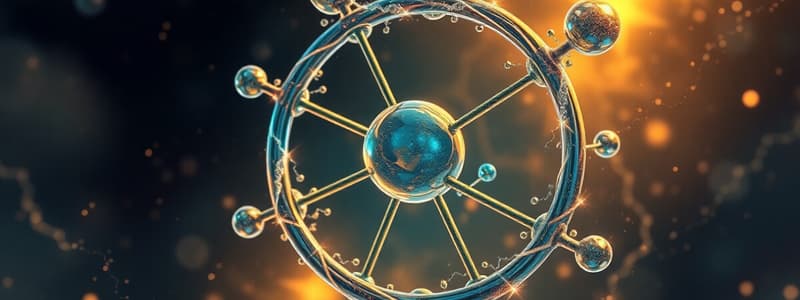Podcast
Questions and Answers
Which of the following describes the nature of contact forces?
Which of the following describes the nature of contact forces?
- They act on objects only upon contact. (correct)
- They are always stronger than field forces.
- They occur only in fluids.
- They act at a distance without physical contact.
The Earth’s magnetic north pole is the same as the geographical north pole.
The Earth’s magnetic north pole is the same as the geographical north pole.
False (B)
What is the primary component of limestone rock?
What is the primary component of limestone rock?
calcium carbonate
A mixture can be classified as either ________ or heterogeneous.
A mixture can be classified as either ________ or heterogeneous.
Match the following components with their descriptions:
Match the following components with their descriptions:
Which planets in our solar system are primarily made up of gases and ice?
Which planets in our solar system are primarily made up of gases and ice?
The weight of an object on the moon is greater than its weight on Earth.
The weight of an object on the moon is greater than its weight on Earth.
What is the term for the phase of the moon when it is completely dark?
What is the term for the phase of the moon when it is completely dark?
The gravitational field intensity on Earth is _____ N/kg.
The gravitational field intensity on Earth is _____ N/kg.
Match the following elements with their symbols:
Match the following elements with their symbols:
What is the primary use of a Hoffmann voltameter?
What is the primary use of a Hoffmann voltameter?
The weight of an object with a mass of 60 kg on Earth is 600 N.
The weight of an object with a mass of 60 kg on Earth is 600 N.
When three-quarters of the right part of the moon's side is illuminated, it is in the _____ phase.
When three-quarters of the right part of the moon's side is illuminated, it is in the _____ phase.
Which of the following best describes the nature of seawater?
Which of the following best describes the nature of seawater?
A sodium chloride molecule is considered an element molecule.
A sodium chloride molecule is considered an element molecule.
Explain what makes an atom electrically neutral.
Explain what makes an atom electrically neutral.
The hydrogen molecule (H2) is considered a __________ molecule.
The hydrogen molecule (H2) is considered a __________ molecule.
Match the following types of matter with their definitions:
Match the following types of matter with their definitions:
What is the main reason why the nucleus of an atom is positively charged?
What is the main reason why the nucleus of an atom is positively charged?
Energy level (M) is saturated with electrons before energy level (N).
Energy level (M) is saturated with electrons before energy level (N).
What happens to the moon during a total eclipse?
What happens to the moon during a total eclipse?
Flashcards
What is the mass number?
What is the mass number?
The total number of protons and neutrons in the nucleus of an atom.
What is a homogeneous mixture?
What is a homogeneous mixture?
A type of mixture where the components are evenly distributed and cannot be easily distinguished by the naked eye.
What are field forces?
What are field forces?
A type of force that acts on objects without direct physical contact, such as gravity and magnetism.
What is evaporation and condensation?
What is evaporation and condensation?
Signup and view all the flashcards
What is magnetic separation?
What is magnetic separation?
Signup and view all the flashcards
Microbes
Microbes
Signup and view all the flashcards
Root Nodule Bacteria
Root Nodule Bacteria
Signup and view all the flashcards
The Moon
The Moon
Signup and view all the flashcards
Umbra (Shadow Area)
Umbra (Shadow Area)
Signup and view all the flashcards
Penumbra
Penumbra
Signup and view all the flashcards
Transparent Objects
Transparent Objects
Signup and view all the flashcards
Opaque Objects
Opaque Objects
Signup and view all the flashcards
Lunar Eclipse
Lunar Eclipse
Signup and view all the flashcards
Active Volcanoes on Venus and Earth
Active Volcanoes on Venus and Earth
Signup and view all the flashcards
Gas Giants: Uranus and Neptune
Gas Giants: Uranus and Neptune
Signup and view all the flashcards
Sun's Apparent Rise
Sun's Apparent Rise
Signup and view all the flashcards
Earth's Tilted Axis and Seasons
Earth's Tilted Axis and Seasons
Signup and view all the flashcards
Waxing Gibbous Moon
Waxing Gibbous Moon
Signup and view all the flashcards
Full Moon Phase
Full Moon Phase
Signup and view all the flashcards
New Moon Phase
New Moon Phase
Signup and view all the flashcards
Mass vs. Weight
Mass vs. Weight
Signup and view all the flashcards
Study Notes
Atomic Structure and Bonding
- An atom is the smallest building block of matter.
- Isotopes are different forms of the same element with the same atomic number but different mass numbers.
- A positive ion (cation) is formed when a metal atom loses one or more electrons.
- A negative ion (anion) is formed when a non-metal atom gains one or more electrons.
- Ionic bonds form from the electrostatic attraction between oppositely charged ions (cations and anions).
- Covalent bonds form when atoms share electrons.
- Valence electrons are the electrons in the outermost energy level of an atom, and are involved in bonding.
- Boiling point is the temperature at which a substance changes from a liquid to a gas.
- Melting point is the temperature at which a substance changes from a solid to a liquid.
- Magnetic materials are attracted to magnets.
- Non-magnetic materials are not attracted to magnets.
- Magnetic poles with similar polarities repel each other; opposite poles attract.
- A magnetic field is the region around a magnet where its force is felt.
- Gravitational force attracts objects towards the center of the Earth.
- Contact forces act between objects when they touch.
- Field forces act on objects across a distance without touching.
- Orbital motion is the revolution of an object around a central body in a curved path.
- Mass is the amount of matter in an object.
- Weight is the force of gravity on an object.
Cells and Organisms
- Prokaryotes are single-celled organisms without a nucleus or membrane-bound organelles.
- Eukaryotes are single-celled or multicellular organisms with a nucleus and membrane-bound organelles.
- Cells are the basic structural and functional units of all living organisms.
- Stem cells are undifferentiated cells that have the ability to develop into specialized cell types.
- Autotrophs are organisms that produce their own food through photosynthesis.
- Heterotrophs are organisms that consume other organisms for food.
- Cellular respiration is the process of breaking down organic molecules (like glucose) to release energy in the presence of oxygen.
Matter, Mixtures and Chemical Reactions
- Microbes are microscopic living organisms, some beneficial and some harmful.
- Root nodule bacteria live in the roots of legumes and help plants absorb nitrogen.
- The moon appears illuminated because it reflects sunlight.
- The umbra is the darkest part of a shadow; the penumbra is the lighter part.
- Transparent objects allow light to pass through them; opaque objects do not.
- A lunar eclipse occurs when Earth passes between the sun and the moon.
- A total eclipse is when the moon is completely in Earth's shadow; a partial eclipse is when only part of the moon is in Earth's shadow.
- Wood floats on water because its density is less than that of water; iron sinks because its density is greater.
- Helium gas is not flammable and is lighter than air.
- Stainless steel resists rusting.
- Aircraft structures use aluminum-titanium alloys for strength and low weight.
- Aerogel is an excellent insulator.
- Vitamin D regulates calcium and phosphorus in the blood.
- Nickel and cobalt are magnetic, while aluminum and silver are not.
- Iron filings are attracted to the poles of a magnet most strongly.
- Objects fall towards Earth's center due to gravity.
- The Moon has a weaker gravitational field than Earth.
- Bacteria can be prokaryotes or eukaryotes; paramecia and euglena are unicellular eukaryotes.
- Green algae are producers, or autotrophs, like plants.
- Rabbits are consumers, or heterotrophs, needing to eat producers like plants.
- Mercury's surface has many craters from impacts.
- Uranus' atmosphere is blue-green due to methane.
- The moon reflects sunlight and appears bright even if it is not self-luminous.
- The total lunar eclipse occurs when the moon passes entirely into Earth’s shadow.
Electromagnetism and Other Concepts
- Lemon juice turns litmus paper red.
- Wood floats on water while iron sinks.
- Chlorine and sodium form an ionic compound (NaCl).
- Chlorine and hydrogen form a covalent compound (HCl).
- A carbon atom bonds to four hydrogen atoms to form methane.
- Charged objects exert forces on each other, either attractive or repulsive, depending on their charge.
- Electric shocks are caused by discharging of electric charges.
- Plants need nitrogen to build proteins.
- The decomposition by bacteria of plant roots releases nitrogen into the soil.
- Bacteria are essential in converting proteins and other nitrogen containing organic molecules back into simple forms in the soil.
- Food will be digested through a one-way path, beginning in the mouth and concluding in the anus, not a closed cycle.
Measurements and Calculations
- An object with a mass of 60 kg on the Moon weighs 100 N on the Moon.
Periodic Table and Atomic Structure
- The periodic table orders elements by increasing atomic number.
- Elements in the same group (column) have similar properties.
- Atomic radius generally increases down a group and decreases across a period.
- Properties like melting and boiling points are related to the atomic radii.
Electrolysis
- Electrolysis is used to split water into its components: hydrogen and oxygen.
Studying That Suits You
Use AI to generate personalized quizzes and flashcards to suit your learning preferences.




